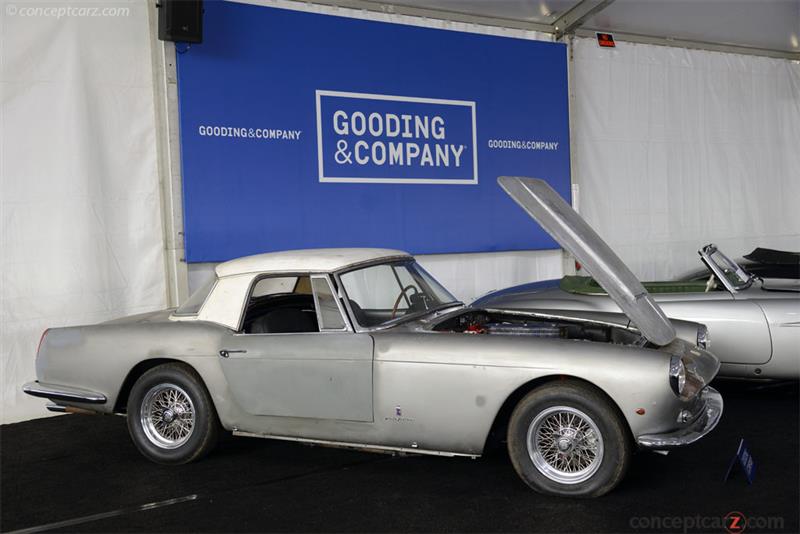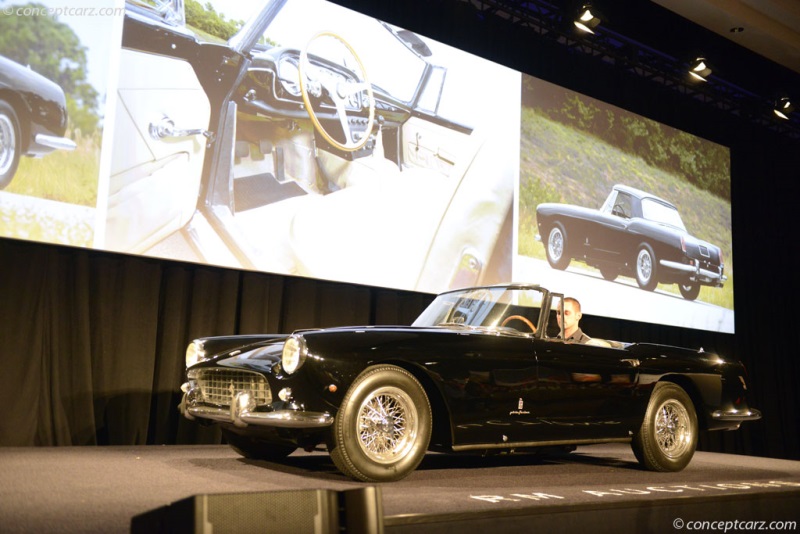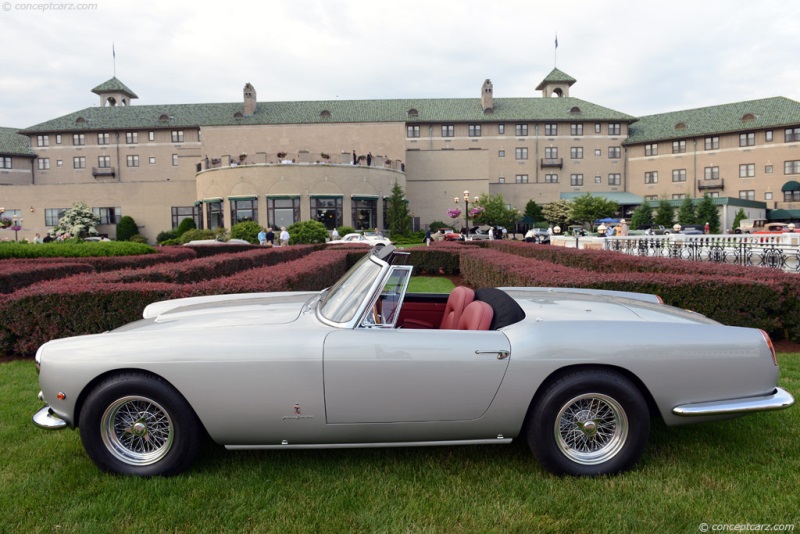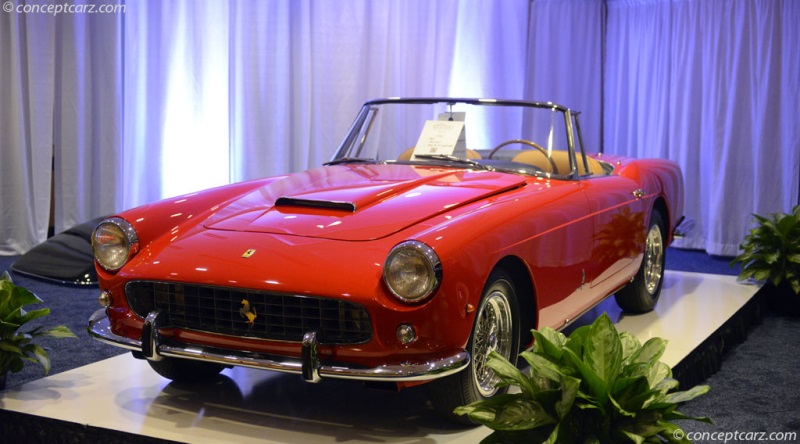The Ferrari 250 GT Series II Cabriolet was introduced in 1959 at the Paris Salon and represented the final evolution of the company's line of drop-top 250 Cabriolet and Spyders. By this point in history, the 250 GT family had firmly established the Maranello marque as the unquestioned market leader, building the fastest and most desirable race-winning sports and GT cars of their time. Sales were strong thanks in part to their worldwide dealership network, which included forty-one dealers in seventeen countries, including twelve in Italy. The company's 250 GT Coupes, designed for touring, were being built alongside the dual-purpose road/race 250 GT Berlinettas. The cabriolet had been a natural progression and a means of expanding the range's market potential.
Cabriolet
Chassis #: 3807 GT
Engine #: 3807
View info and history
Auction entries : 2250 Series Genesis
Road car production had become vitally important to Ferrari's financial stability, and the 250 Series, Ferrari's first volume-produced model, was an integral part of that equation. The first of the line - the 250 Europa - was built from 1953 to 1954, with a total output of fewer than 20. Before the Europa, Ferrari had constructed road-going coupes and convertibles in small quantities, often for special customer orders. Beginning with a sports-racing chassis as the basis, the vehicles often received coachwork from Ghia, Viganle, or Touring, and no two cars were alike as there was no attempt at standardization for series production.Vignale had been Maranello's preferred carrozzeria, but with the introduction of the 250 Europa, Pinin Farina (later 'Pininfarina') would be Ferrari's number one choice, bodying no fewer than 48 out of the 53 Europa/Europa GTs built. A new Ferrari 250 GT road car was shown in March 1956 at the Geneva Salon, however, the Torinese Carrozzeria was not yet in a position to cope with the increased workload. Production was entrusted to Carrozzeria Boano after Pinin Farina had completed a handful of prototypes.At the heart of the 250 Series was the compact Colombo-designed 3.0-liter V12, replacing its predecessor's bulkier Lampredi unit. The all-aluminum single-overhead-camshaft unit offered a lively 220 horsepower at 7,000 RPM. The 250 GT chassis, shorter by 200mm than that of the Europa, followed Ferrari's established practice of a multi-tubular frame held together by oval main tubes, however, the previous transverse leaf-type independent front suspension gave way to coil springs. Power was sent to the live rear axle via a four-speed all-synchromesh gearbox, and braking was by hydraulic drums all round.
Cabriolet
Chassis #: 3427 GT
View info and historyAround 353 examples of Pininfarina's 'notch back' Coupe were built between 1958 and 1960 within the sequence '0841' to '2081,' a figure closer to true series production. Although significant for Ferrari, it remained a relatively small scale of production, meaning that cars could still be ordered with subtle variations according to customer choice. Several show cars and 'specials' were constructed on the 250 GT chassis, giving glimpses of future design directions.A variety of body styles were offered by many prominent European coachbuilders on the 250 GT chassis, with Scaglietti and Pininfarina producing open-top spyder and cabriolet models. Carrozzeria Boano was the first coachbuilder to design a convertible body for Ferrari's new 250 GT chassis, and its flamboyant design marked the beginning of a new era for Ferrari. The first of Pininfarina's 250 GT Cabriolets was shown a year later, in 1957, at the Geneva Salon (chassis 0655GT) and was the first of four prototypes, each with a unique design. Enthusiastically received, they laid the groundwork for the series of cabriolets that followed (as many as 40 in total plus four prototypes). Several design traits from the prototypes were incorporated on Series I bodies, including the covered headlights, long hood, rear fenders that kick-up, wind-up windows, recessed rear tail lights, and a simple raked windshield without vent windows. These grand tourers were 'production cars' but were constructed in Pininfarina's custom shop, each with unique features.The Series II Cabriolets, from 1959, was the true Ferrari production series, being built with a more standardized body type.Ferrari's California Spyder and Cabriolet
Both the California Spyder and Cabriolet offered open-top motoring, yet their purpose was completely different. The California was the 'wild child' and was all about the experience. The Cabriolet was much more refined and favored luxury, yet - like its California sibling - could 'let its hair down' from time to time. The California was built by Scaglietti, and its DNA, bearing similar lines, was obvious. The interior revealed significant differences, as its simplistic accouterments enabled freedom of movement and the ability to feel the elements.
Cabriolet
Chassis #: 3427 GT
View info and historyThe Cabriolet was built by Pininfarina, and its interior was graced by only the very finest materials. Each of the Cabriolets was built to the particular interests of the clientele, giving it an aura of exclusivity. The styling was more refined and reserved, but underneath its bonnet was the 3.0-liter V12 produced 240 horsepower. Zero to sixty mph was accomplished in seven seconds, and the top speed was in excess of 140 mph.In short, the 250 GT Cabriolet offered a wholly different driving experience than its race-ready siblings and was marketed as a true gentleman's grand tourer. It was designed for comfort and high-speed driving, and exquisitely trimmed and appointed to satisfy Ferrari's most demanding clientele. Even the spacious boot could accommodate more than enough luggage for two for a long weekend trip.Series II
Pinin Farina's second-series 250 GT Cabriolet began with a prototype design built in late 1959 on chassis number 1213 GT. Debuting at the 1959 Paris Motor Show, significant visual differences helped distinguish it from the California Spyder. There was a slightly more rounded nose, open headlamps, and rear fenders with elongated tail lamp lenses. Additional interior space was intended to improve passenger comfort, and the trunk gained extra space as well.
Cabriolet
Chassis #: 3427 GT
View info and historyAlong with stylistic changes, the second-series 250 GT Cabriolet introduced a number of mechanical updates. The engine was the latest iteration of the Colombo V-12 engine, designated Tipo 128F, with the spark plugs relocated to the outside (rather than in-between the V), and the coil-valve springs gave way to hairpins (the original 128C 3.0-liter engine was superseded by the twin-distributor 128D, which in turn was supplanted in 1960 by the outside-plug 128F engine). This new architecture allowed for more head studs per cylinder and non-siamesed porting. The engine's breathing, torque, and reliability improved, and it was much easier and quicker to change the plugs. The 'outside-plug,' 60-degree, single overhead camshaft, Colombo V-12 engine displaced 2,953cc and produced around 240 horsepower. Four-wheel hydraulic disc brakes arrived late in 1959, and a four-speeds-plus-overdrive gearbox arrived the following year. The 250 GT Series II had a 102.4-inch wheelbase chassis and an independent front suspension with A-arms, coil springs, and telescopic shocks. The live rear axle was suspended by semi-elliptic springs and telescopic shock.
Cabriolet
Chassis #: 3427 GT
View info and historyApproximately 200 examples of the second-series Pinin Farina Cabriolet were produced through mid-1962.
by Daniel Vaughan | Jan 2024
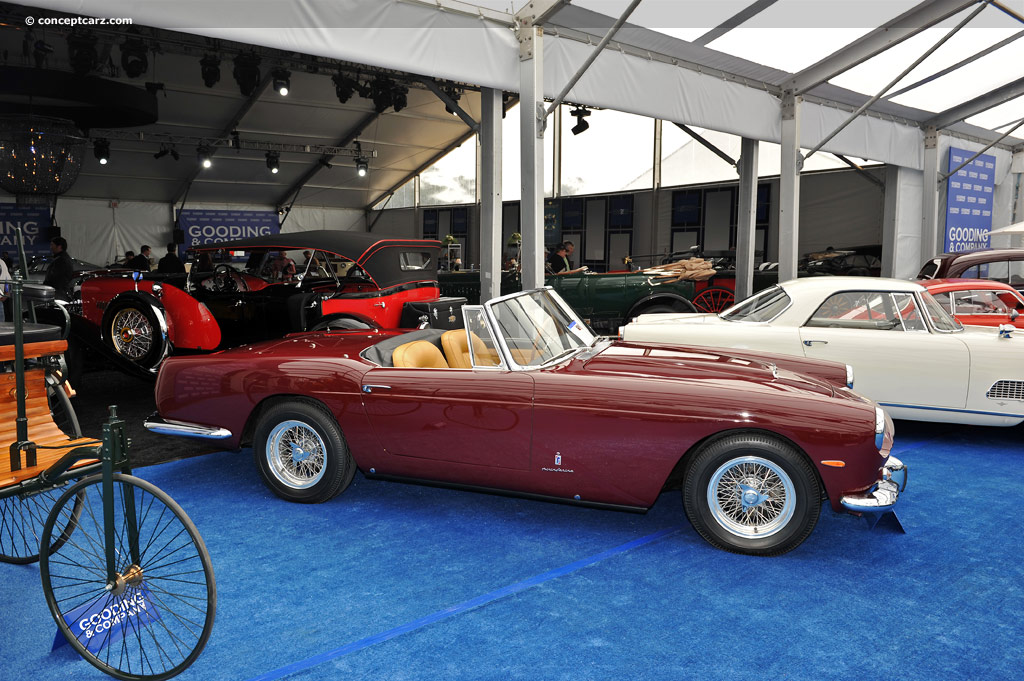
Cabriolet
Chassis #: 3807 GT
Engine #: 3807
View info and history
Auction entries : 2
Road car production had become vitally important to Ferrari's financial stability, and the 250 Series, Ferrari's first volume-produced model, was an integral part of that equation. The first of the line - the 250 Europa - was built from 1953 to 1954, with a total output of fewer than 20. Before the Europa, Ferrari had constructed road-going coupes and convertibles in small quantities, often for special customer orders. Beginning with a sports-racing chassis as the basis, the vehicles often received coachwork from Ghia, Viganle, or Touring, and no two cars were alike as there was no attempt at standardization for series production.Vignale had been Maranello's preferred carrozzeria, but with the introduction of the 250 Europa, Pinin Farina (later 'Pininfarina') would be Ferrari's number one choice, bodying no fewer than 48 out of the 53 Europa/Europa GTs built. A new Ferrari 250 GT road car was shown in March 1956 at the Geneva Salon, however, the Torinese Carrozzeria was not yet in a position to cope with the increased workload. Production was entrusted to Carrozzeria Boano after Pinin Farina had completed a handful of prototypes.At the heart of the 250 Series was the compact Colombo-designed 3.0-liter V12, replacing its predecessor's bulkier Lampredi unit. The all-aluminum single-overhead-camshaft unit offered a lively 220 horsepower at 7,000 RPM. The 250 GT chassis, shorter by 200mm than that of the Europa, followed Ferrari's established practice of a multi-tubular frame held together by oval main tubes, however, the previous transverse leaf-type independent front suspension gave way to coil springs. Power was sent to the live rear axle via a four-speed all-synchromesh gearbox, and braking was by hydraulic drums all round.
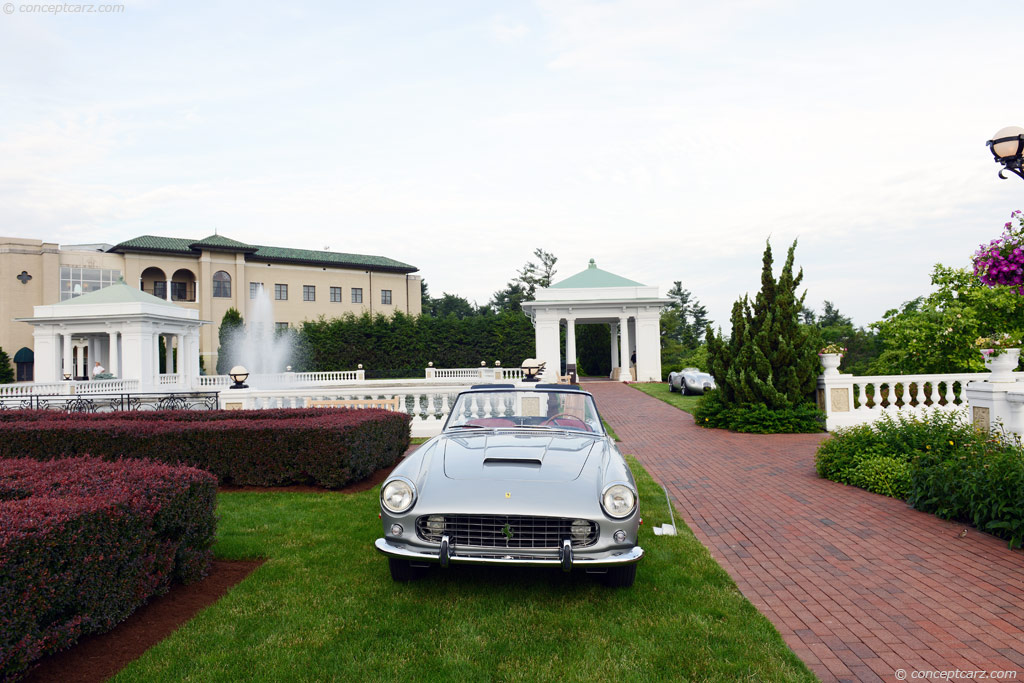
Cabriolet
Chassis #: 3427 GT
View info and history
Both the California Spyder and Cabriolet offered open-top motoring, yet their purpose was completely different. The California was the 'wild child' and was all about the experience. The Cabriolet was much more refined and favored luxury, yet - like its California sibling - could 'let its hair down' from time to time. The California was built by Scaglietti, and its DNA, bearing similar lines, was obvious. The interior revealed significant differences, as its simplistic accouterments enabled freedom of movement and the ability to feel the elements.
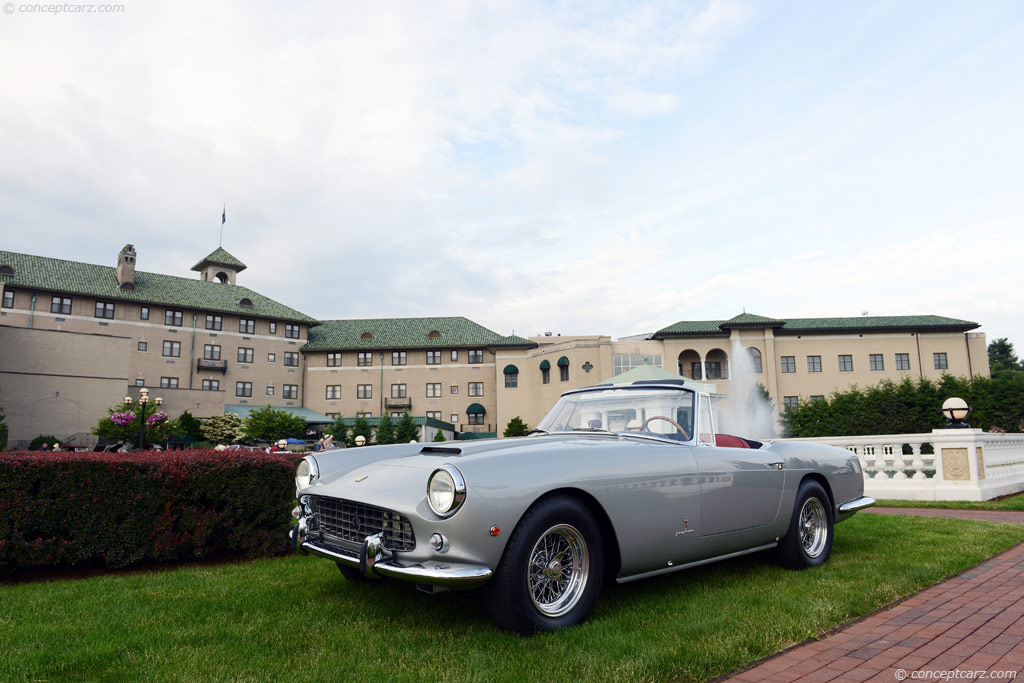
Cabriolet
Chassis #: 3427 GT
View info and history
Pinin Farina's second-series 250 GT Cabriolet began with a prototype design built in late 1959 on chassis number 1213 GT. Debuting at the 1959 Paris Motor Show, significant visual differences helped distinguish it from the California Spyder. There was a slightly more rounded nose, open headlamps, and rear fenders with elongated tail lamp lenses. Additional interior space was intended to improve passenger comfort, and the trunk gained extra space as well.
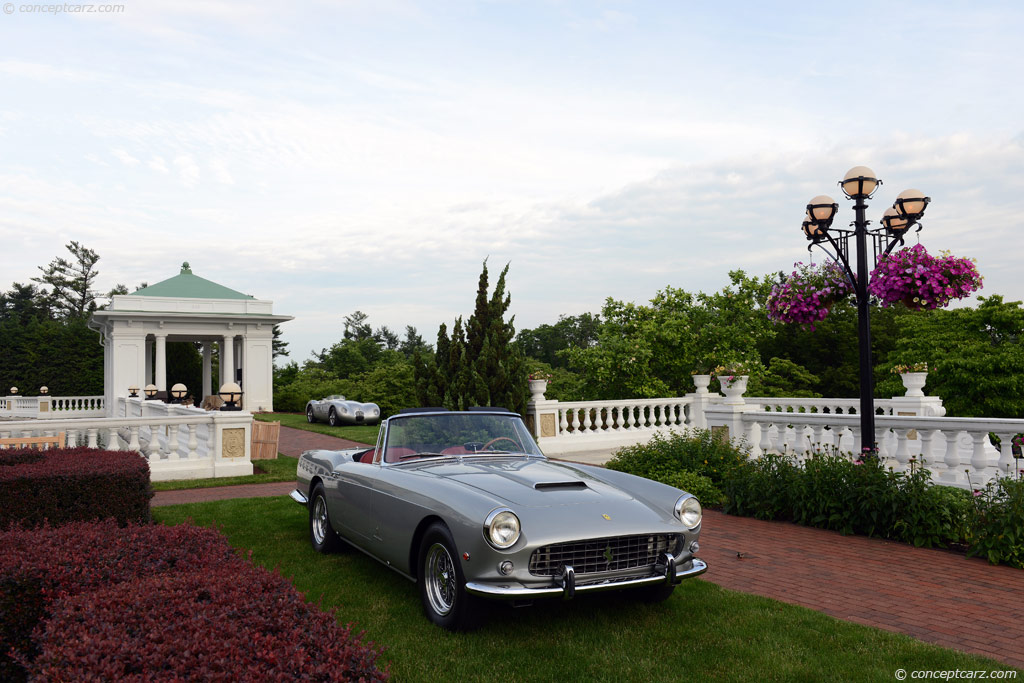
Cabriolet
Chassis #: 3427 GT
View info and history
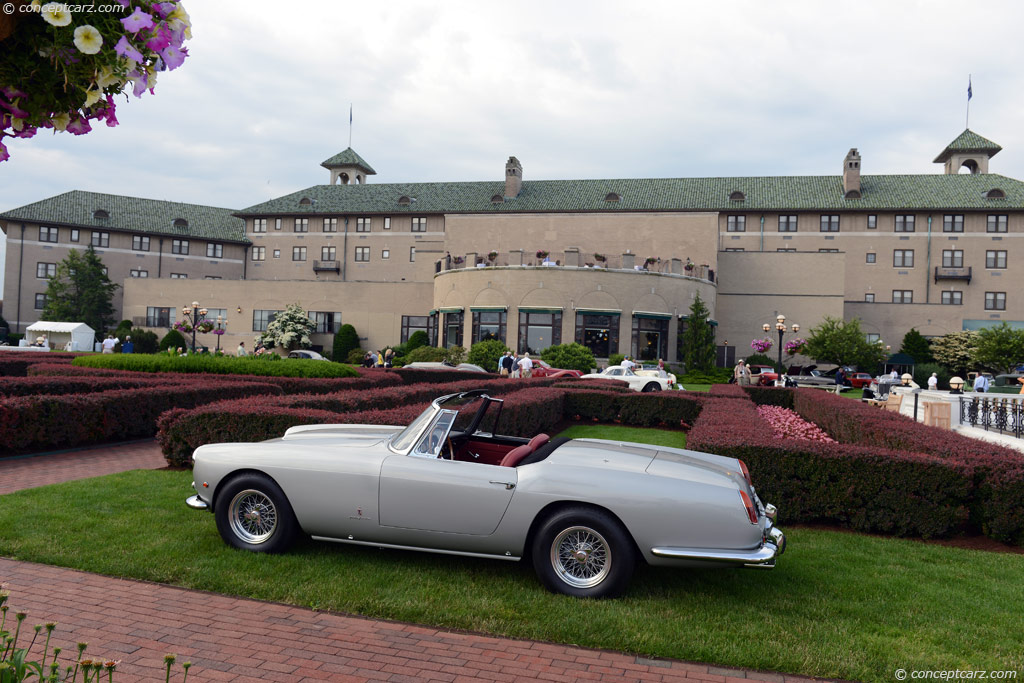
Cabriolet
Chassis #: 3427 GT
View info and history
by Daniel Vaughan | Jan 2024
Related Reading : Ferrari 250 GT History
Production of the 250 Series began in 1954 and continued on through the early part of the 1960s. There were numerous variations of the 250 and would ultimately become Ferraris most successful line of vehicles to date. The 250 is also recognized as the first Ferrari to ever receive disc brakes. This did not take place until the end of the 1950s. Also, the 250 was the first four-seater. Ferraris....
Continue Reading >>
Continue Reading >>
Similar Automakers
Similarly Sized Vehicles
from 1962
Similarly Priced Vehicles
1962 Ferrari 250 GT Series II Vehicle Profiles
Recent Vehicle Additions
Performance and Specification Comparison
Price Comparison
$12,600
250 GT Series II Specification Comparison by Year
Year
Production
Wheelbase
Engine
Prices
Related Automotive News

Pebble Beach Auctions Online Catalogue Now Live; Historic, Unrestored 1962 Ferrari 250 GT SWB Berlinetta Unveiled as Headlining Car
Gooding %26 Company launches its entire online catalogue for the Pebble Beach Auctions, announces a remarkably original 1962 Ferrari 250 GT SWB Berlinetta along major Italian star cars.
Gooding %26 Company, the official auction house of the Pebble...

1962 Ferrari 250 GT SWB California Spider to Lead Gooding & Company's Amelia Island Auctions Alongside Stable of the Finest Ferraris
The star car of the auctions will be a one-off 1962 Ferrari 250 GT SWB California Spider, joined by a 250 GT Tour de France Berlinetta, a 250 MM Vignale Spider, and other examples of Maranellos finest models.
Leading international auction...

Where it all started: Enzo's first production model heads up incomparable set of Maranello greats as Salon Privé celebrates Ferrari's 75th anniversary
Salon Privé Concours dElégance presented by Aviva assembles rare and hallowed Ferrari models, the like of which has never been seen before at a UK Concours
Notables include 1947 125 S (first production Ferrari ever built, on loan from factory),...

Phenomenal Ferraris and Italian Thoroughbreds Offered at Gooding & Company's Pebble Beach Auctions
The auction house announced a stable of Italian star cars, including a 1950 Ferrari 166 MM Berlinetta Le Mans, a 1961 Ferrari 400 Superamerica Series I Coupe Aerodinamico, and a 1954 Ferrari 500 Mondial Series I Spider.
A stunning group of star...

REVERED FERRARI 250 LM LEADS SUPERLATIVE ROSTER OF ITALIAN SPORTS CARS AT RM'S FLAGSHIP MONTEREY SALE
· RM Auctions announces a legendary 1964 Ferrari 250 LM by Scaglietti as the latest multi-million-dollar highlight for its flagship Monterey sale, August 15–16 in California
· 250 LM leads a superb roster of no less than 26 Ferraris at...



























